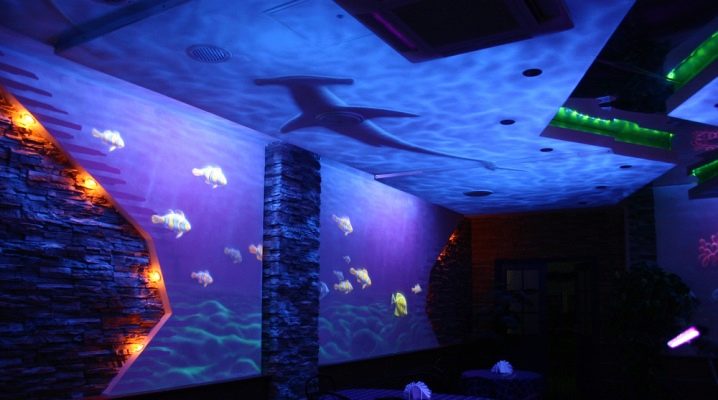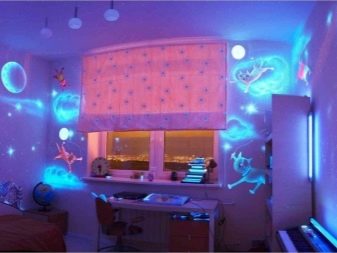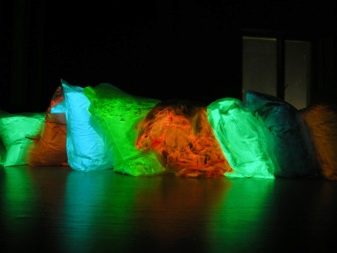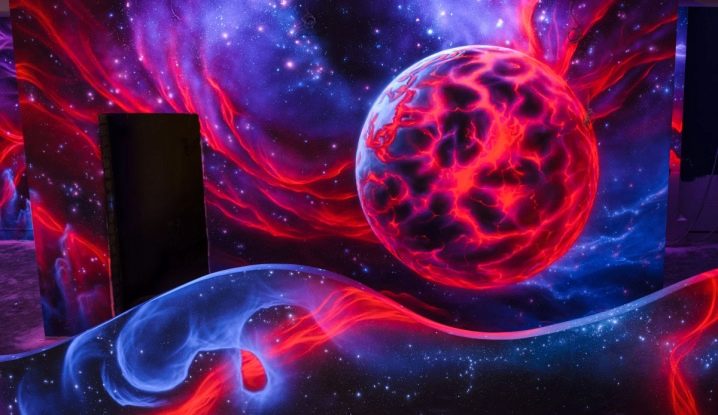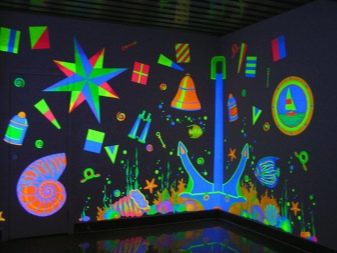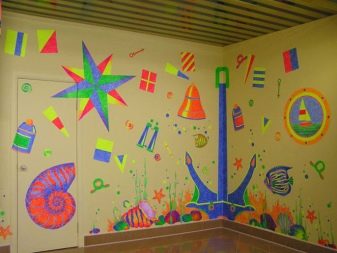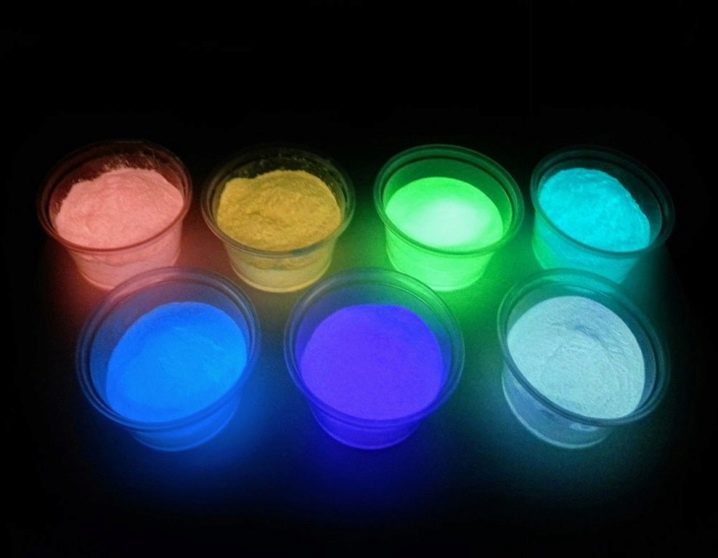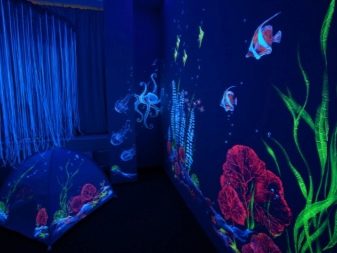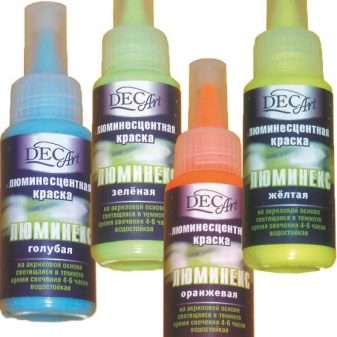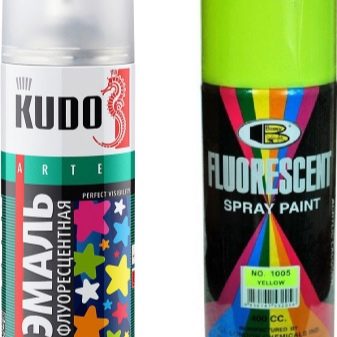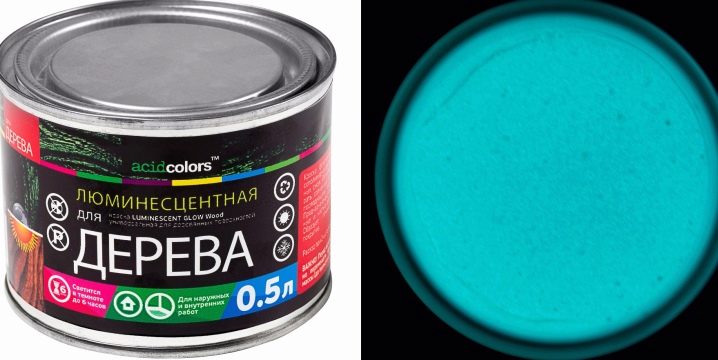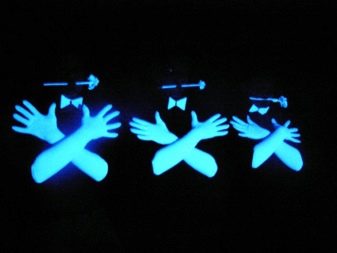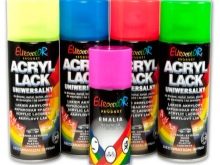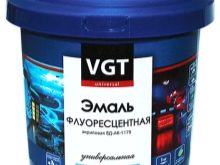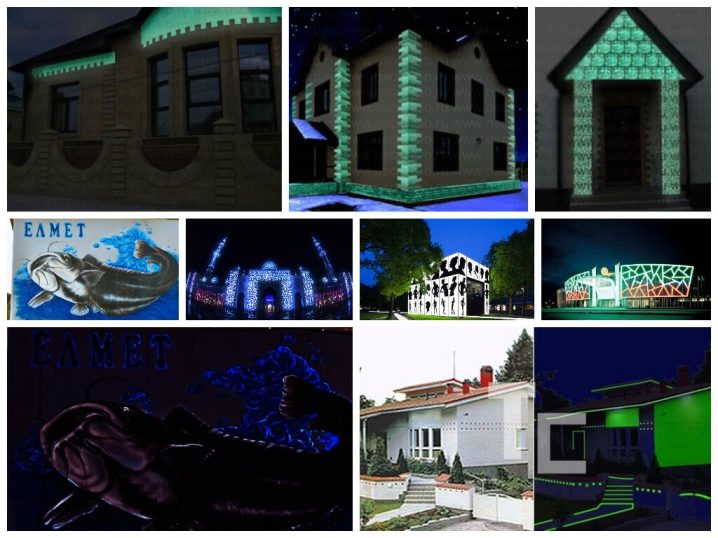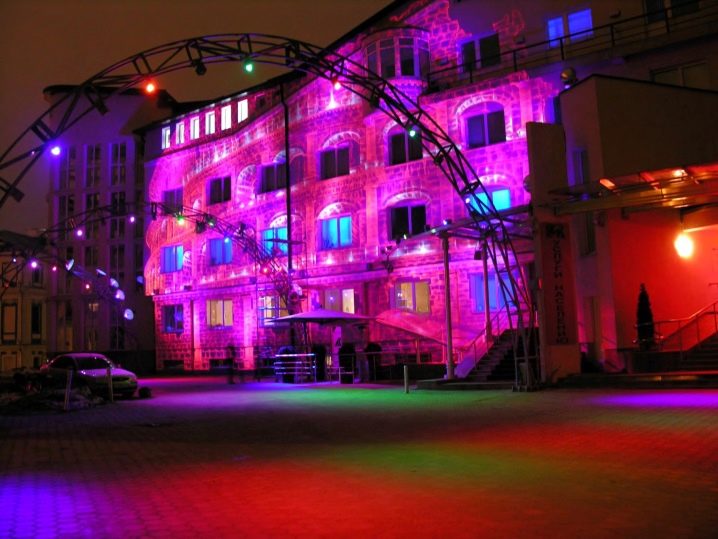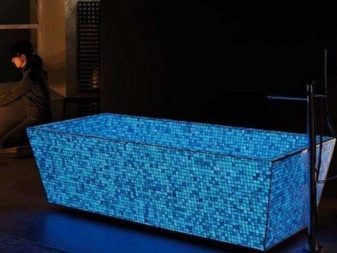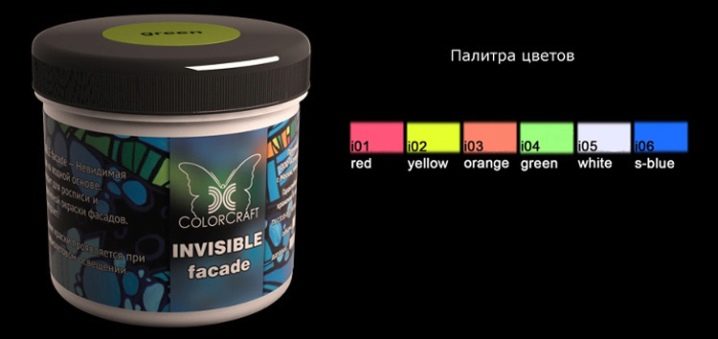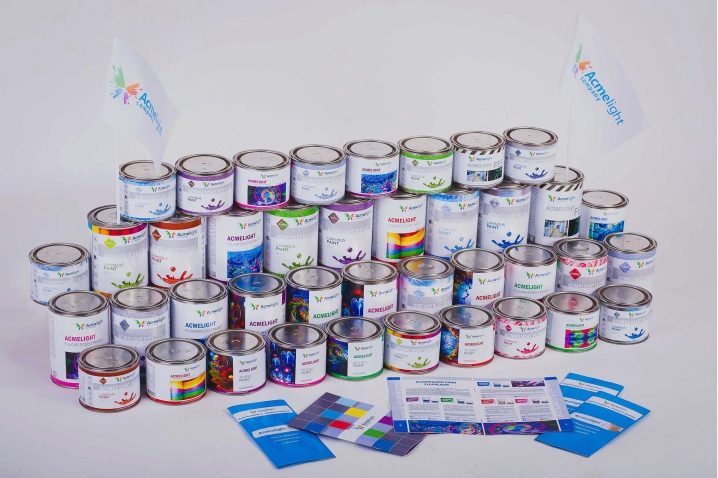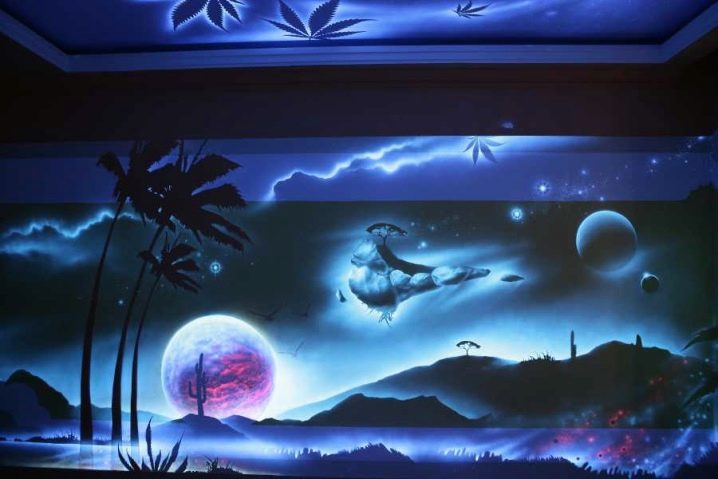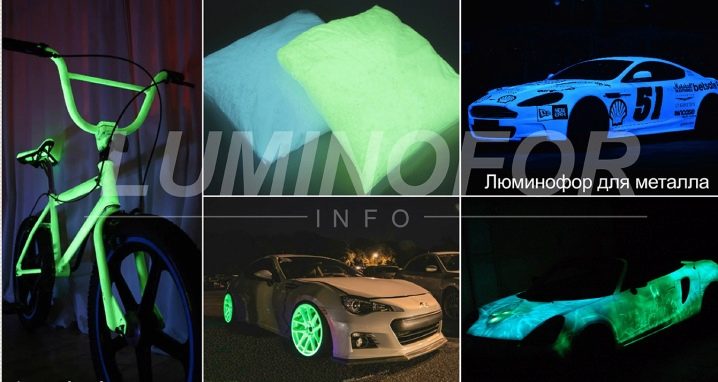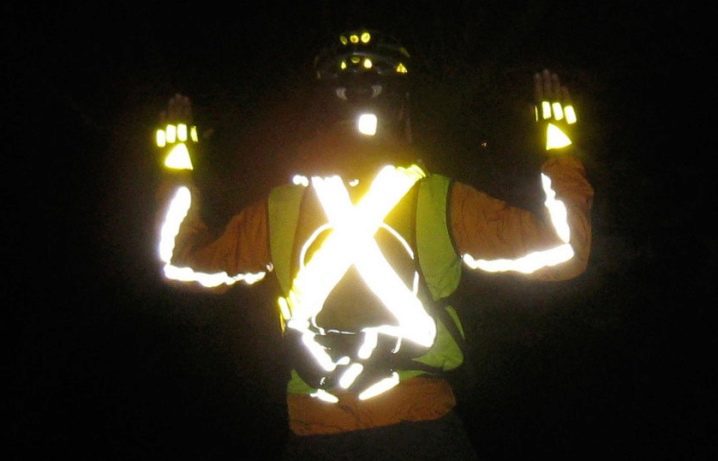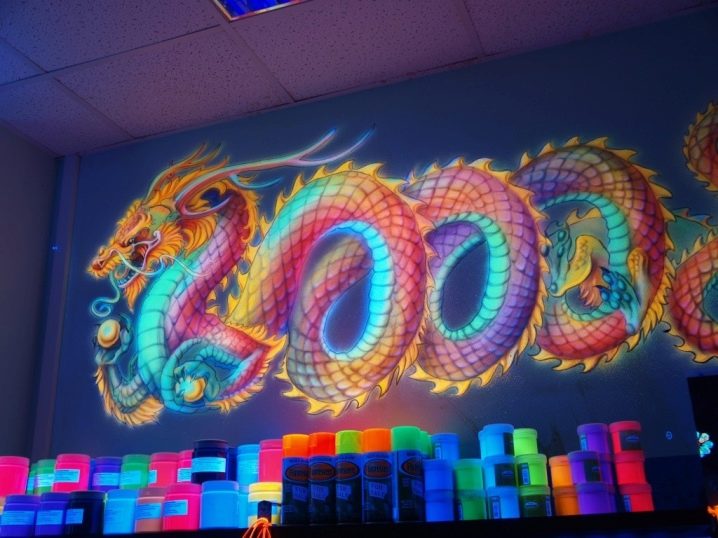Fluorescent paints: properties and scope
During repairs, interior design, designers and craftsmen use fluorescent paint. What it is? Does spray paint glow in the dark in cans?
Answers to these and other questions regarding fluorescent dye will be given by this article.
What it is?
Fluorescent paint coatings, or phosphor-based paints are a special kind of material that is distinguished by a special reaction to light rays. When the direction of the paint simple light rays or ultraviolet increases the volume of the image and many times increases the brightness.
The use of fluorescent paints has become frequent in the work of graphic artists and designers, who transform ordinary gray spaces into a space that attracts attention and delight.
Properties
Fluorescent paints are endowed with special properties - luminescence. This is the effect of a special glow at night. During the day, the surface painted with this paint accumulates light energy, and at night it gives up. Shimmer with different shades and gleam in the dark painted surface is capable of up to twelve hours.
Everything is glowing under the UV light. 15 minutes of daylight is enough for her to charge with an overnight glow..
In addition, the pigment which is a part of a paint and varnish product possesses one more unique property - gives to the painted surface or drawing acid color saturation. The color gamut is wide - from crimson to lemon hue.
The unique properties of fluorescent dyes can be considered:
- Light reflecting effect, which can reach 150-300%. To understand the uniqueness, you should compare this effect with ordinary paint, in which it barely reaches 85%.
- Full safety in use, because there are no harmful components in the composition.
- The effect of glowing in the dark can last long enough.
What is different from fluorescent?
Luminous paints have long taken their place of honor in the modern world, settling forever in many industries and directions. The facets of the use of paints today simply do not exist - they are used on land, under water, in space.
There are two types of luminous paint coatings that have significant differences:
- fluorescent;
- fluorescent.
Fluorescent paint - it is a paintwork material, which is based on the phosphor. Products or surfaces painted by it glow in the dark. Often used by artists to create drawings, paintings. The pigment contained in it feeds on solar energy or bright artificial light throughout the day, and illuminates the painted surface and everything around at night.
The features of this paint include:
- a pigment size of five microns;
- smoothness and perfect evenness of the surface on which the paint is applied;
- half-hour recharge for a 12-hour glow;
- the presence of a greenish and bluish glow, which is present due to the phosphor;
- long service life of paint, which reaches 30 years;
- frost resistance;
- moisture resistance;
- the absence of toxic substances that adversely affect human health;
- high cost.
Fluorescent paint - the coloring material which does not eat solar energy, and shines under the influence of ultraviolet rays. The fluorescent component is not glowing, but only reflects the light spectrum.
The features of this paint are:
- continuous luminescence under the action of ultraviolet rays;
- the color palette includes eight bright colors, as well as many different shades that are formed when mixing colors;
- the pigment size of the finished paint reaches 75 microns;
- at hit of sunshine fluorescent paint grows dull and burns out;
- does not withstand high temperature regimes, when the drop just collapses;
- affordable price segment.
If we talk about whether luminous dye is harmful to health, the answer is obvious - no, therefore the range of its application is very wide.
Kinds
Today, fluorescent paint is presented on the market in four main types:
- Acrylic enamel for use in decorating the premises. Often used when updating or changing the interior.
- Acrylic enamel, which is designed to paint the facades of houses.
- Spray paint, which includes urethane and alkydan. It is a universal paint coating. Available this type of coating in cans, convenient for use.
- Invisible paint. They are almost invisible on light surfaces, but this is during daytime. At night, they acquire a whitish hue in the form of chaotic divorces. They are often used by designers in exclusive projects. The use of such paint found in highlighting road signs.
Enamel for interior decoration can be applied to almost any surface, whether it be wood, plasterboard surfaces, paper, stone. Exceptions are plastic and metal surfaces.
The color shade of acrylic enamel is determined by its composition, which includes acrylic as a base and fluorescent pigment particles. New shades are obtained by mixing the existing colors.
The paint does not have an unpleasant pungent odor. It is not toxic. The disadvantages include low moisture resistancetherefore it is better not to use it in a bathroom, the pool.
Acrylic enamel, intended for painting the facades of buildings, is very resistant, withstands different temperature conditions. It is resistant to fading and sufficiently resistant to means of cleaning and disinfection. It is not difficult to wash a house painted with such enamel.
Facade paint has no odors. She has excellent vapor permeability. It fits well on the concrete surface, galvanized metal, which can not be said about many other types of paint coatings.
If the purpose of the paint is to paint a picture on the wall of the house, then it must first be diluted with a liquid (plain water).
The spray paint belonging to the class of universal coloring agents has a wide range of uses. They are used for interior and exterior use. The process of applying such paint is simplified due to the fact that it is produced in small cans. Aerosol coloring agent can be applied to many types of surfaces:
- glass;
- plastic;
- tree;
- surface of the walls.
They are ideal for use in the bathroom, pool, toilet, because they have the highest vapor resistance.
Invisible paint - a very popular type of paintwork. She has a rich range of colors. Ordinary white walls or ceilings in the daytime magically turn into masterpieces of designers and artists at night, reflecting various colors. All this thanks to the ultraviolet.
Colors
The color palette of fluorescent paint is represented by a small number of colors, among which are yellow, red, blue, orange, white, and purple. Amazing is the fact that the purple hue is the faded of the entire color palette represented.
The color can also vary from the initial colorless to an acidic tone, and when the action of ultraviolet rays passes, the acid becomes colorless again. Also, achromatic (colorless) colors turn into an amazing yellow, green, orange tone.
All fluorescent dyes are divided into chromatic and achromatic. Chromatic give amplification of tone due to the action of ultraviolet rays. For example, red paint becomes even brighter and more saturated, but the tone does not change. Achromatic colors are the transformation of colorless tones into saturated colors.. For example, it was colorless, and became bright orange.
Also, fluorescent paint coatings have the property of reincarnation from one shade to another - it was blue, it became green. Invisible or transparent fluorescent paint does not have its own color in daylight. Tint appears at night.
Manufacturers
Well-known manufacturers of aerosol coloring materials in cans are two brands - Kudo and Bosny. Also in specialized points of sale of this type of product you can find such brands as Noxton, New Ton, Acmelight, Tricolor, “Champion” and others.
Producing countries that have proven themselves in the market for fluorescent coloring agents are Poland, Ukraine, and Russia.
Application
The scope of application of luminous coloring materials is very large. She came to us from ancient times. Once upon a time, African tribes loved to use it, painting their bodies and faces. Gradually, unusual coloring material became popular throughout Europe, and then throughout the world.
In painting, a separate direction is developed - flowrescent. Its representatives are talented painters A. Thompson, B. Varnayte.
Today it is difficult to name an environment where paints are not used, because their use is permitted and necessary everywhere.
Spheres where luminous paint is often used:
- Decorating walls, ceilings, facades of buildings.
- The decoration of public institutions (night clubs, restaurants, cafes).
- Fine art and painting.
- Registration of furniture and interior. Restoration of old furniture.
- Body art, including manicure and makeup. Face painting Tattoo
- Decoration of compositions from fresh and artificial flowers.
- Textile dyeing, including garments.
- Coloring leather goods, bags, backpacks.
- Painting of facades, fences, wooden arbors.
- Advertising. Application on packaging, labels, stickers, banners.
- Auto tuning and airbrushing.
- Bike tuning.
- Use in workwear and road signs.
In addition to all the above, the paint can be seen on the dishes, souvenirs, household appliances. The field of forensic science has long used them in their work.
Manufacturers of products for children use luminous paints to attract the attention of children's audiences. With the help of invisible paint manufacturers apply protective markings on their products, thus protecting themselves from fakes.
Creative people paint pictures, murals. Christmas tree decorations painted with luminous colors, painted statuettes and other figures look great.The film industry and show business is also not without fluorescent coloring materials.
Coloring agents, like any other materials, you need to be able to choose the right. First, you need to understand exactly why they are needed, and secondly, to know where they will be applied. If the goal is set, then you can decide on the view, and only then choose shades.
For more information on fluorescent paint, see the video below.
